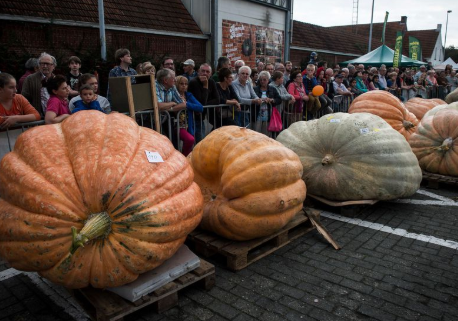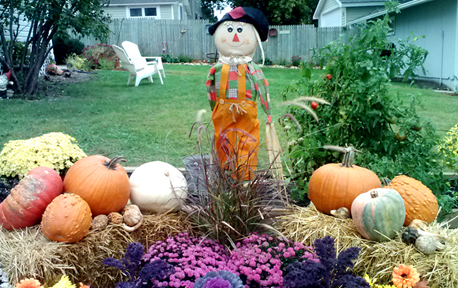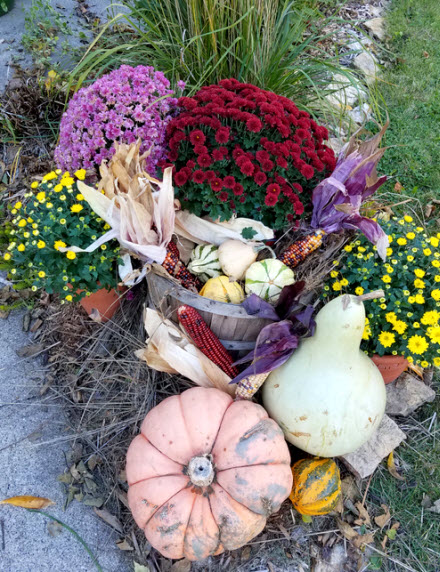Click below to listen to my 2 min. Garden Bite radio show: Fall landscape
Audio Player
Some folks grow gourds or specialty squash for howlingly cool Halloween or Harvest displays. Once, many years ago, I grew one of those super large pumpkins. I was so proud! The local grocery store was having a contest and I got it loaded up in the pick up and off we went. The grocery store manager says, “Ya that woulda won!”
Huh?
“The contest ended yesterday”.

If you grew corn this year you have a great tall accent for your decor, cut the stalks and tie them to bamboo or hidden p-v–c pipe to keep them propped up.
Should you use bales of straw or hay for lawn decorations, keep in mind they’ll kill your grass if left longer than a few weeks.

Those fallen leaves can be used for decoration before composting using kids clothes and rubber bands. Stuff the clothes with the leaves to overflowing closing the holes with rubber bands. I’ve put them in wheelbarrows using pumpkins as their heads or prop them up against trees. If you have a penchant for scaring people, hang a few in the trees!

If they haven’t been blown to bits by the wind, you can preserve small branches of Fall-colored leaves by setting them in a glycerin/water mixture for a few days.
Preserving Fall branches from Martha Stewart. If you go to the site you have to sift through a bunch of advertising…
materials
- Cut branches with leaves
- Pruning clippers or handsaw
- Hammer
- Deep bucket
- pH testing kit (lemon juice or powdered lime, if pH is off)
- Glycerin (available at local drugstores)
- Surfectant, such as Spreader Sticker (available at local garden centers)
- Florist’s wire; wreath form
steps
- Select a dozen or so small but leaf-heavy branches from trees at their peak of color. For best results, cut branches at night. Use ones that have not weathered a frost this season; the process will not work on leaves that have seen a frost. Keep in mind that glycerin will change the leaves’ colors. Yellows respond best, becoming more intense; reds and oranges turn a ruddy brown; green magnolia leaves take on a chestnut color but retain their glossy veneer.
- Cut branches from trees with pruning clippers or a handsaw. Pound the end of each branch with a hammer to expose its vascular system.
- Fill a deep bucket with a half-gallon of water. Test the water with a pH testing kit to make sure it has a pH between 3 and 4. (If pH is too high, add citric acid — lemon juice. If too low, add powdered lime.) Add 17 ounces (2 cups plus 2 tablespoons) of glycerin and 4 to 5 drops of surfactant to the water. (The surfactant breaks down the glycerin molecules into smaller ones, enabling the branches to absorb glycerin more easily.)
- Stand the branches in the bucket; place them out of sunlight while the branches and leaves draw up glycerin. After 3 to 5 days, leaves will feel supple. Magnolia branches may take 3 to 6 weeks to absorb the glycerin.
- Pick leaves from branches and, with florist’s wire, bind into small bunches. Position a bunch on a wreath form and bind with wire to hold in place. Wire on a second bunch so that leaves overlap wired stems. Continue until circle is complete.
This method is easy and great for indoor and outdoor use making garlands, wreaths or just placing them upright in pots.
Ornamental grasses are great for adding texture, form and, sometimes, color.
I have also been known to spray paint spent sedum flowers. You can do the same thing with hydrangea flowers too.
These are just some simple ideas that won’t cost much of anything and it’s a fun project to share with kids, grandkids or make it a party with friends and a glass of wine!
From simple to whatever you want, it’s fun to have a little something greeting you at your door!



